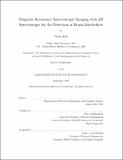Magnetic resonance spectroscopic imaging with 2D spectroscopy for the detection of brain metabolites
Author(s)
Kok, Trina
DownloadFull printable version (3.052Mb)
Other Contributors
Massachusetts Institute of Technology. Department of Electrical Engineering and Computer Science.
Advisor
Elfar Adalsteinsson.
Terms of use
Metadata
Show full item recordAbstract
While magnetic resonance imaging (MRI) derives its signal from protons in water, additional biochemical compounds are detectable in vivo within the proton spectrum. The detection and mapping of these much weaker signals is known as magnetic resonance spectroscopy or spectroscopic imaging. Among the complicating factors for this modality applied to human clinical imaging are limited chemical-shift dispersion and J-coupling, which cause spectral overlap and complicated spectral shapes that limit detection and separation of brain metabolites using MR spectroscopic imaging (MRSI). Existing techniques for improved detection include so-called 2D spectroscopy, where additional encoding steps aid in the separation of compounds with overlapping chemical shift. This is achieved by collecting spectral data over a range of timing parameters and introducing an additional frequency axis. While these techniques have been shown to improve signal separation, they carry a penalty in scan time that is often prohibitive when combined with MRSI. Beyond scan time constraints, the lipid signal contamination from the subcutaneous tissue in the head pose problems in MRSI. Due to the large voxel size typical in MRSI experiments, ringing artifacts from lipid signals become more prominent and contaminate spectra in brain tissue. This is despite the spatial separation of subcutaneous and brain tissue. This thesis first explores the combination of a 2D MRS method, _Constant Time Point REsolved SpectroScopy (CT-PRESS) with fast spiral encoding in order to achieve feasible scan times for human in-vivo scanning. Human trials were done on a 3.OT scanner and with a 32-channel receive coil array. A lipid contamination minimization algorithm was incorporated for the reduction of lipid artifacts in brain metabolite spectra. This method was applied to the detection of cortical metabolites in the brain and results showed that peaks of metabolites, glutamate, glutamine and N-acetyl-aspartate were recovered after successful lipid suppression. The second task of this thesis was to investigate under-sampling in the indirect time dimension of CT-PRESS and its associated reconstruction with Multi-Task Bayesian Compressed Sensing, which incorporated fully-sampled simulated spectral data as prior information for regularization. It was observed that MT Bayesian CS gave good reconstructions despite simulated incomplete prior knowledge of spectral parameters.
Description
Thesis (Ph. D.)--Massachusetts Institute of Technology, Dept. of Electrical Engineering and Computer Science, 2012. Cataloged from PDF version of thesis. Page 94 blank. Includes bibliographical references (p. 87-93).
Date issued
2012Department
Massachusetts Institute of Technology. Department of Electrical Engineering and Computer SciencePublisher
Massachusetts Institute of Technology
Keywords
Electrical Engineering and Computer Science.